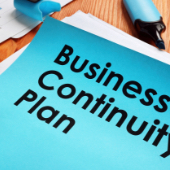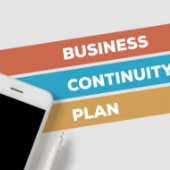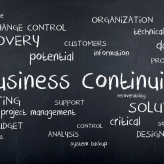 A variety of untoward events can disrupt the operations of small- to medium-sized businesses (SMBs), including natural disasters or cyberattacks. These incidents can cause SMBS to lose revenue, or in some extreme cases, close permanently. Fortunately, having a concrete business continuity plan (BCP) in place will help your business recover quickly after a disaster.
A variety of untoward events can disrupt the operations of small- to medium-sized businesses (SMBs), including natural disasters or cyberattacks. These incidents can cause SMBS to lose revenue, or in some extreme cases, close permanently. Fortunately, having a concrete business continuity plan (BCP) in place will help your business recover quickly after a disaster.
What is a BCP?
A BCP is a predefined set of protocols on how your business should respond in case of an emergency or natural disaster. It contains contingency plans for every aspect of your organization, including human resources, assets, and business processes.
Key threats to business continuity
Various types of threats can affect SMBs such as:
- Natural disasters: These are natural phenomena such as floods, storms, earthquakes, and wildfires.
- Man-made disasters: These include cyberattacks, intentional sabotage, and human negligence.
- Equipment and utility failures: These include unexpected power failures, internet downtime, and disruption of communication services.
How to build an effective BCP
If your company does not have a BCP in place, now is a good time to create one. These steps will help you formulate an effective BCP that will ensure your company keeps running even during a major crisis.
- Perform a risk assessment
To create an effective BCP, it’s important to identify the risks to prioritize. Start by identifying potential threats that may impact your daily operations. List down as well industry risks, geographical area, rising trends, and issues that your stakeholders may encounter. Next, categorize the risks based on the level of impact, likelihood of occurrence, or other criteria.Once risks have been identified and a plan has been developed, carefully identify any possible gaps. Collaborate with your team to identify any weak points in the plan, and make changes as necessary. - Perform a business impact analysis (BIA)
A BIA will help you determine how a disruption can affect your company’s current functions, processes, personnel, equipment, technology, and physical infrastructure. IT will also help you calculate the potential financial and operational loss from each function and process affected. - Identify your recovery options
Identify key resources for restoring your business to minimum operational levels. Some recovery options you can take include using data backups, allowing employees to work from home or operating from a secondary location. - Document the plan
Make a record of the BCP and store the document in a secure location, preferably an off-site one to reduce the risks of loss or damage in case of a disaster. - Test and train
Once your BCP is in place, your continuity team needs to perform tests regularly to identify gaps and make necessary changes to ensure the plan’s effectiveness. They also need to conduct regular employee training so that everyone knows their respective roles should a disaster strike.
Having an effective BCP is a great way to ensure your business can quickly recover after a major disaster. If you’re thinking about creating a BCP for your company but don’t know where to start, give us a call today.

 Do you know why some small- to medium-sized businesses (SMBs) fail during the first five years of operation? Poor leadership is one reason, inadequate capital is another. Another possible cause is the lack of preparation for major disruptions like natural disasters and cyberattacks. If you want to prevent this from happening to your business, you need a business continuity plan (BCP).
Do you know why some small- to medium-sized businesses (SMBs) fail during the first five years of operation? Poor leadership is one reason, inadequate capital is another. Another possible cause is the lack of preparation for major disruptions like natural disasters and cyberattacks. If you want to prevent this from happening to your business, you need a business continuity plan (BCP). Many small- to medium-sized business (SMB) owners fail to prepare for major crises like flood and ransomware attacks. Disaster events can cause downtime, which can result in lost revenue and lower profits. In addition, SMBs that fail to recover quickly from disruption face the risk of losing their customers to their competitors. To prevent this from happening to you, it’s important to have a business continuity plan (BCP) in place.
Many small- to medium-sized business (SMB) owners fail to prepare for major crises like flood and ransomware attacks. Disaster events can cause downtime, which can result in lost revenue and lower profits. In addition, SMBs that fail to recover quickly from disruption face the risk of losing their customers to their competitors. To prevent this from happening to you, it’s important to have a business continuity plan (BCP) in place. Business continuity plans (BCPs) are designed to protect an organization’s critical data in case of a crisis. But there is more to BCPs than securing data; it also entails making sure employees are safe during a disruption. If you want an infallible business continuity plan, cover every base and avoid the following mistakes.
Business continuity plans (BCPs) are designed to protect an organization’s critical data in case of a crisis. But there is more to BCPs than securing data; it also entails making sure employees are safe during a disruption. If you want an infallible business continuity plan, cover every base and avoid the following mistakes. In the event of a disaster, businesses must make sure that their servers and data are safe. Many companies, however, wrongly assume that merely having data backups guarantees business continuity. Here are other top mistakes companies should avoid when preparing for the worst-case scenario.
In the event of a disaster, businesses must make sure that their servers and data are safe. Many companies, however, wrongly assume that merely having data backups guarantees business continuity. Here are other top mistakes companies should avoid when preparing for the worst-case scenario. Every business owner knows that having a business continuity plan (BCP) is crucial to surviving any disaster. However, some still tend to overlook certain aspects of a BCP strategy, causing the plan to go up in flames. Ensure a solid BCP by knowing these five critical mistakes to avoid.
Every business owner knows that having a business continuity plan (BCP) is crucial to surviving any disaster. However, some still tend to overlook certain aspects of a BCP strategy, causing the plan to go up in flames. Ensure a solid BCP by knowing these five critical mistakes to avoid. Hurricanes damage property and put lives at risk. If you’re not prepared, hurricanes can also disrupt your operations and put your business through extended downtime. In this blog, we’ll help you quickly regain access to your data and get your business back to operational mode after a disaster.
Hurricanes damage property and put lives at risk. If you’re not prepared, hurricanes can also disrupt your operations and put your business through extended downtime. In this blog, we’ll help you quickly regain access to your data and get your business back to operational mode after a disaster. Hurricanes are a common occurrence in many parts of the United States. Not only do they destroy property and endanger lives, but they can also disrupt your business’s operations. In this blog, we offer tips on how you can ensure fast access to your data following a disaster and immediately get back to business.
Hurricanes are a common occurrence in many parts of the United States. Not only do they destroy property and endanger lives, but they can also disrupt your business’s operations. In this blog, we offer tips on how you can ensure fast access to your data following a disaster and immediately get back to business. As hurricanes are a common event in many areas of the United States, business owners must take steps to secure their data. In this blog, we provide steps that will help you quickly recover your data and get back to business following a hurricane.
As hurricanes are a common event in many areas of the United States, business owners must take steps to secure their data. In this blog, we provide steps that will help you quickly recover your data and get back to business following a hurricane. Modern businesses use data in almost every aspect of their operations. Without immediate and constant access to it, organizations will come to a grinding halt. That’s why it’s critical to have data backups — in the event of a disaster, companies risk losing valuable data if they don’t have backup strategies in place. Here are four data backup solutions you can implement to prevent such a scenario.
Modern businesses use data in almost every aspect of their operations. Without immediate and constant access to it, organizations will come to a grinding halt. That’s why it’s critical to have data backups — in the event of a disaster, companies risk losing valuable data if they don’t have backup strategies in place. Here are four data backup solutions you can implement to prevent such a scenario. Businesses rely heavily on data for their daily operations. They use it for everything, from building client relationships to developing marketing strategies and so much more. But without data backups, businesses risk losing data in case of a disaster. Every business owner must develop a robust backup plan for their business, which includes implementing any or all of the following solutions.
Businesses rely heavily on data for their daily operations. They use it for everything, from building client relationships to developing marketing strategies and so much more. But without data backups, businesses risk losing data in case of a disaster. Every business owner must develop a robust backup plan for their business, which includes implementing any or all of the following solutions. Data is valuable to business, so it’s bizarre that some companies don’t have a proper data backup strategy in place. Organizations of all sizes — including yours — need to be proactive when backing up their data. Here are four of the best backup solutions in the market for your consideration.
Data is valuable to business, so it’s bizarre that some companies don’t have a proper data backup strategy in place. Organizations of all sizes — including yours — need to be proactive when backing up their data. Here are four of the best backup solutions in the market for your consideration.